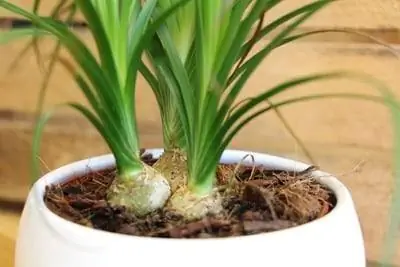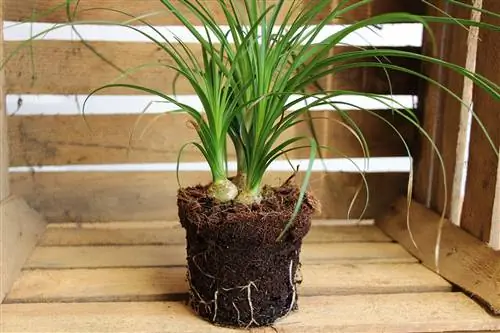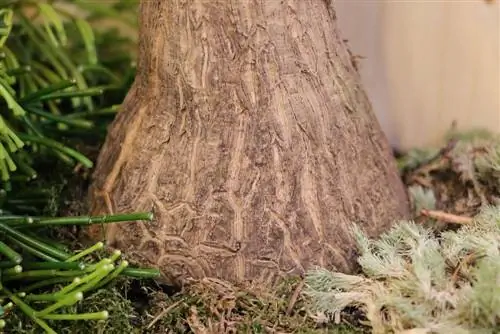- Author admin [email protected].
- Public 2023-12-17 03:39.
- Last modified 2025-01-24 12:45.
If you look at the elephant's foot, you immediately know where its name comes from. An elephant foot is the perfect houseplant: decorative and easy to care for. It also forgives if you forget to water it. Like the agave, which is closely related to the elephant's foot, this plant can store water. However, not in the leaves, but in the thickened trunk. The elephant's foot, which is also called the water palm or bottle tree, grows particularly beautifully if you follow a few tips when caring for it.
Short profile
- Botanical name: Beaucarnea recurvata
- other names: bottle tree, water palm
- belongs to the agave family within the asparagus family
- succulent plant
- forms a bottle-shaped trunk as it ages
- green tuft of leaves in the vegetation zone
- long, narrow leaves that hang in an arch shape
Occurrences
In its native Mexico and Texas, the bottle tree reaches a height of several meters and can easily survive both scorching heat and long dry periods. Beaucarnea recurvata, as the bottle tree is botanically called, is perfectly adapted to exactly these conditions. The thick trunk stores water to survive extended dry periods while keeping evaporation via the leaves to a minimum level. The term water palm only describes half the truth, because the bottle tree does not belong to the palm trees, but to the agave family within the asparagus family. That's why the elephant's foot is very closely related to the yucca palm.
Location
The elephant's foot, which thrives in hot climatic conditions in its homeland, also needs a place in the room that is as sunny as possible. However, newly purchased specimens and water palms that have been slightly darker over the winter must first slowly be accustomed to the blazing sun again. However, since its leaves burn easily on south-facing windows, east or west windows are better. Alternatively, a curtain or roller blind can protect south-facing windows from the sun.
- Light requirements: sunny to light partial shade
- Temperature: tends to be hot in summer
- If possible, no midday sun
- not below 5 degrees in winter
- Soil: must be well drained
- medium to low nutrient levels
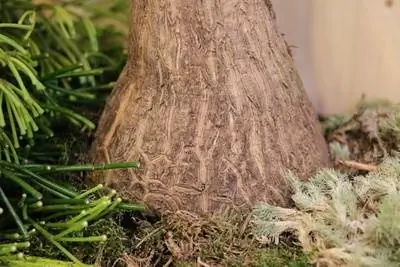
The bottle tree is not very sensitive to temperatures as long as they do not fall below five degrees. It is easily possible to cultivate the plant on the balcony in summer. However, the elephant's foot needs a period of getting used to it. Otherwise the delicate leaves can get sunburned. Sunburn manifests itself as brown, usually irregular spots on the green foliage. The destroyed tissue no longer heals and looks very unsightly for a long time. That's why it's best to put the elephant's foot in a semi-shady place outdoors for two weeks at the beginning of the summer season. Morning and evening sun are initially sufficient to stimulate growth. After getting used to it, the plant can then be moved to its final, sunny location. She can then spend the summer there until the temperatures drop below 10 degrees at night.
Tip:
Since Beaucarnea recurvata always orients itself towards daylight, it is a good idea to rotate the plant on the windowsill regularly so that it does not grow crooked.
Substrate
As a succulent plant, the elephant's foot requires a nutrient-poor substrate that is well permeable to water so that it does not become waterlogged. The following substrates are suitable for cultivation:
- Cactus soil
- Succulent soil
- Potting soil with loosening additions
- Additives: sand, clay granules, pumice gravel, coco hume, expanded clay, lava granules
- alternatively loamy garden soil mixed with leaf mold
- the pH value should ideally be between 5.8 and 6.8
Pouring
Beaucarnea recurvata does not require much more water than cacti. For this reason, extensive watering is inappropriate. Nevertheless, you should not keep the bottle tree too dry during the vegetation phase. Regular but cautious watering is therefore optimal. In principle: it's better to be too dry than too wet. Because the bottle tree begins to rot when the root ball is wet. In summer, especially when it is allowed to enjoy the sun on the balcony or terrace, the root ball can be submerged and then slowly dried out over a longer period of time before the next watering.
- water a little more in spring and summer
- Almost not at all in winter (bit by bit)
- The substrate should dry thoroughly between watering
Tip:
Excess water must be able to drain freely. The water should be poured out of the planter after five minutes at the latest.
Fertilize
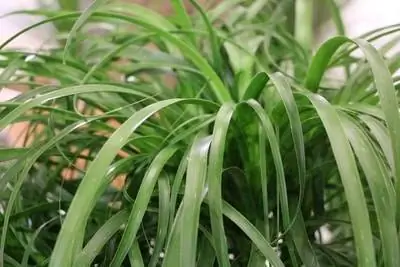
During the growth phase between April and the beginning of August, the bottle tree can be fertilized with commercially available liquid fertilizer for succulents. Since the plant's nutrient requirements are not particularly high, a small amount every two weeks is sufficient. When using green plant fertilizer, only half the amount recommended by the manufacturer should be used. Between September and March the elephant's foot is in the resting phase and is not fertilized.
Cutting
A water palm tree does not need to be cut. It grows very slowly anyway and only forms its leaves at the upper vegetation point of the trunk. Dead or wilted leaves can be removed regularly. It is also possible to saw off the trunk, which becomes increasingly thin towards the top, if the plant becomes too large for the windowsill. The best time for this is early spring. To avoid infection, the interface should be coated with charcoal ash. After a short time, the bottle tree will sprout again just below the cut point, usually at several points at the same time. Sometimes the long thin leaves of the elephant's foot grow down so far that they touch the floor (or windowsill). Anyone who cuts the leaves must expect that unsightly brown tips will form at the cuts, which then also have to be removed. A bottle tree with an overly long tuft of leaves should therefore be planted in an elevated position, for example by placing an upturned flower pot under it.
- Trunk cut about 20-30 cm high
- cut/saw as smoothly and straight as possible
- Disinfect cutting surface with charcoal ash
- place in a partially shaded, warm place
- water slightly less than normal
Repotting
Since the elephant's foot grows very slowly, it is sufficient to repot it every three to five years. At the latest when the thickened trunk covers the entire surface of the substrate, the time has come for a larger pot and fresh substrate. Beaucarnea recurvata should preferably be repotted before the growing season.
- Time: early spring (March)
- Pot size: about two centimeters more space on each side of the bale than before
- Pot shape: preferably wide and flat (shallow roots)
- flat vessels prevent waterlogging
- shake old soil from the roots
- remove dead roots
- do not plant deeper than before
- after repotting, protect from direct sun for two to three weeks
Propagate by seeds
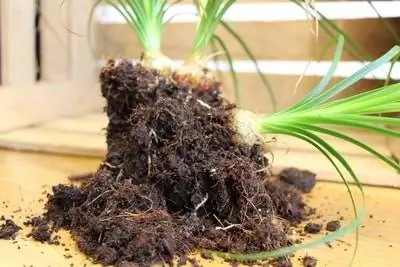
The elephant's foot can be propagated using seeds, which are available in well-stocked specialist stores. Cultivation from seeds is quite simple, but it strains the patience of any amateur gardener who expects quick results. It may take a few years before the plant even forms a visible trunk that thickens downwards. When it is young, the bottle tree looks more like a small onion with a few leaves emerging from the top.
- Time: possible all year round
- First soak seeds in water
- place in moist potting soil or cactus soil
- cover with a fine layer of sand
- Cover the pot with a glass plate or place it in a freezer bag
- set up warm
- bright, but no direct sunlight
- ventilate occasionally
If the seeds germinate, the evaporation protection can be removed. This should be done slowly so that the young plant can get used to the changed conditions.
Propagation by cuttings
Cuttings can easily be taken from side shoots on the trunk. To do this, use a clean knife to cut off a he althy shoot that already has at least ten leaves of its own. It is cut so deeply that the cut is no longer in the green shoot, but goes slightly into the woody trunk.
- Time: Spring
- Substrate: cactus soil, growing soil
- alternatively 2/3 peat and 1/3 sand
- moisten slightly
- Insert the shoot about 1 cm deep
- Press the soil lightly
- cover with a transparent pot or plastic bag
- roots will form after a few weeks
- place brightly, but without direct sun
Tip:
The rooting of the cuttings can be recognized by the fact that new leaves appear in the leaf tuft. From now on the plastic bag can be removed.
Wintering
Since the elephant's foot is not hardy, plants that have spent the summer outdoors must be brought indoors when temperatures drop (below 10 degrees). To initiate the rest phase, it is best to place the plant in a cool, bright place.
- Temperature: about 6 to 12 degrees
- frost-free
- bright or partially shaded (without direct sun)
- water very little (little sips)
- do not fertilize
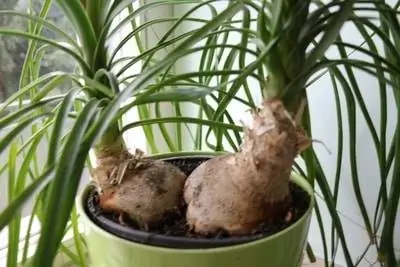
In the cold season, the amount of light is often a problem for the otherwise easy-care elephant foot. He still needs a bright location. If necessary, the light levels must be checked and the location changed. Alternatively, a special plant light can also be a good solution. Only a bottle tree that is placed brightly in winter will remain he althy and free of pests during the rest period. At the beginning of the growing season in spring, water a little more heavily and move the plant to a warmer location.
Tip:
Warm heating air promotes pest infestation. Bright basement rooms, draft-free hallways or a winter garden are better suited for overwintering the bottle tree.
Diseases and pests
Basically, the elephant's foot is not considered to be particularly sensitive to disease or pest infestation. The succulent plant reacts sensitively to temperatures that are too low and too much water during the winter months. Brownish discoloration indicates frost or cold damage. Too much irrigation water usually results in rot and mold formation on the roots or trunk. If the diseased tissue is removed in time and the roots are placed in fresh soil, Beaucarnea recurvata can usually still be saved. However, the plant needs some time to recover.
- Rot and mold if watered too frequently
- Mites and lice usually appear when the humidity is too low (heating air)
- Most common care mistakes: substrate that is too wet, winter quarters that are too dark
Conclusion
The bottle tree is a very robust houseplant that has few demands. That's why it's also suitable for beginners and hobby gardeners who don't have a green thumb. If the few needs of the succulent plant are taken into account, it turns out to be an exotic beauty that will delight for years with its unique shape.

